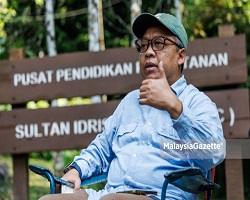Sheena Bidin
Let’s be honest. Children, in general, has limited knowledge and understanding on what carbon storage, carbon sequestration and all the other environmental jargons when it comes to protecting the planet. Yes, they generally have an idea that forest plays a vital role in keeping the earth safe; however like any other average child, their understanding is limited to just that. In fact, research shows that students as well as adults has limited understanding of the concept of carbon storage or sequestration (e.g., Chimoita et al., 2014; Miller et al., 2007; Wang et al., 2021), with some research found as high as 75 percent has never heard of the term (Anghel, 2017).). This is not limited to complicated jargons such as carbon storage and sequestration. Interviews from visitors to a local wildlife sanctuary found that some visitors are unable to grasp the concept of deforestation and its impact on wildlife habitat (Bidin & Hughes, 2016). If children and adults alike struggled to understand the connection of forest and climate change mitigation, we are facing a much larger problem at hand as combating environmental issues needs to be tackled at the grassroot level. The question is how can we help?
This is where to role of recreation planning and product development comes to life and must not underestimated. Planning for nature-based areas includes designing nature-based space and activities that integrates interpretation, environmental education activities, and creative spaces that allows for practical hands-on for children to grasp the environmental concept while enjoying recreational activities. Designs for recreational areas has always advocated for a sense of place and spaces that has a mix of recreational and educational activities with first-hand experiences (Kudryavtsev, Stedman & Krasny, 2012), as this undoubtedly allows children to make meaningful memories and deepen their understanding on the connections surrounding the environment. Numerous studies (e.g., Falk & Adelman,2003; Ballantyne et al.2007) has proved that activities that involves nature-based learning and outdoor recreational activities tremendously improved knowledge, interest in environmental issues as well as fosters pro-environmental behaviors. Surely, well designed parks that offers these experiences are usually observable in nature-based parks, however it should also be incorporated into most recreational areas such as residential parks or in urban parks. Yet, many recreational areas are still lacking in integrating educational and interpretive elements, particularly in spaces that children frequented.
The potential to designing recreational spaces that assist children to enhance their understanding are endless. Influencing the sense of place can integrate instructional and/or experiential approaches (Kudryavtsev et al., 2012) as this helps children to foster deeper connection with the environment. It can be in the form of storytelling and folklores, message contents that simplifies environmental jargons to children in the form of thought-provoking interpretive panels, interactive virtual reality on deforestation, or it could also be simple activities or programs that incorporates role-playing, such as appointing children to be “superheroes of nature”. The concept of role-play for example, are one of the most successful elements in the play industry to spark children interest and imagination, which is why companies such as Lego, Disney and role-play based theme parks such as Kidzania are hugely successful.
Of course, things are always easier said than done. Planning, designing, developing and execution of this said recreational areas necessitates the will and commitment from every stakeholder involved. We must be able to change our perspective and do things the unconventional way especially when it comes to educating and inspiring children in this generation. Yes, another tree planting program with schoolchildren is good, however what are we doing to make it a fun, meaningful and impactful for the students? Did they truly understand the meaning of tree planting and the impact it has on carbon storage and/or carbon sequestration? We are not only facing climate change problems, but we are also facing the challenge of trying to garner the interest of the young generation that is quick to turn their attention sideways to the more interesting wonders of technology such as smartphones, iPads and PlayStation. Therefore, to reiterate, people and personnel involved in designing recreational areas plays a vital role in educating and sparking the interest of the younger generations to really know about the role of forest as carbon store. And this certainly means designing recreational spaces that makes an impact and resonates with children.
References
Anghel, S. (2017). Impact of CCS communication on the general and local public in Romania-Oltenia region. Energy Procedia, 114, 7343-7347.
Ballantyne, R., Packer, J., Hughes, K., & Dierking, L. (2007). Conservation learning in wildlife tourism settings: Lessons from research in zoos and aquariums. Environmental Education Research, 13(3), 367-383.
Chimoita, E. L., Embeywa, H. E., & -Onyango, J. P. G. (2014). Secondary School Teachers’ Understanding of Energy Flow in Ecosystems: Carbon Sink and Sequestration Perspective. Journal of Human Ecology, 48(3), 461-467.
Falk, J. H., & Adelman, L. M. (2003). Investigating the impact of prior knowledge and interest on aquarium visitor learning. Journal of research in science teaching, 40(2), 163-176.
Kudryavtsev, A., Stedman, R. C., & Krasny, M. E. (2012). Sense of place in environmental education. Environmental education research, 18(2), 229-250.
Magalhães, L. (2018). Work and Play in a Theme Park. Toys and Communication, 235-253.
Miller, E., Bell, L., & Buys, E. (2007). Public understanding of carbon sequestration in Australia: socio-demographic predictors of knowledge, engagement and trust. International Journal of Emerging Technologies and Society, 5(1), 15-33.
Sheena, B., & Hughes, K. (2016). Why are you asking me about palm oil and orangutans?” Understanding local and international visitors knowledge of orangutan conservation. In: Scerri, Madalyn (Editor); Hui, Lee Ker (Editor). CAUTHE 2016: The Changing Landscape of Tourism and Hospitality: The Impact of Emerging Markets and Emerging Destinations. Sydney: Blue Mountains International Hotel Management School, 2016: 1063.
Tarikh Input: 12/07/2023 | Kemaskini: 12/07/2023 | masridien
PERKONGSIAN MEDIA




























